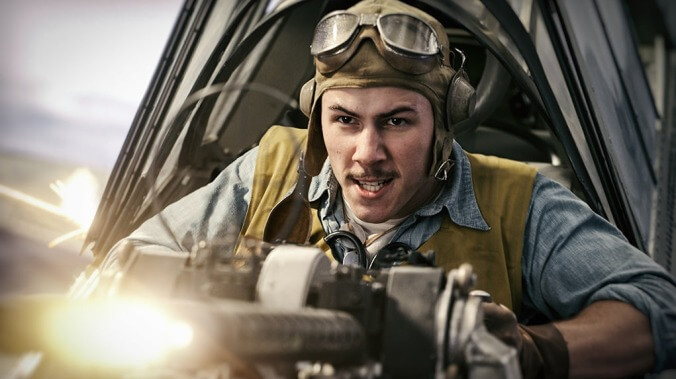One such set of striking features belongs to Dick Best (Ed Skrein), a hotshot dive bomber pilot stationed on the carrier USS Enterprise whose gift for cheating death rarely extends to his tail gunners or wingmen, putting him in conflict with the even more good-looking squadron commander Wade McClusky (Luke Evans). Both of these specimens of testosterone-fueled all-American derring-do (played by Brits who periodically struggle with their accents) are real historical figures, as are almost all of the characters in Midway, which attempts to dramatize the most famous naval battle of World War II by drawing equal inspiration from the monotonous historical reenactments of 1970’s Tora! Tora! Tora!, the butt-numbing soap-opera spectacle of 2001’s Pearl Harbor, and the Irwin Allen influences of Emmerich’s own disaster movies.
Midway takes the larger chunk of its running time to actually get to the eponymous Pacific atoll, near which the United States Navy surprised an attacking Japanese fleet in June of 1942. It begins in Japan in 1937, at a formal dinner where the Japanese-speaking American naval attaché Edwin T. Layton (Patrick Wilson) and the Harvard-educated Japanese admiral Isoroku Yamamoto (Etsushi Toyokawa) sneak away for a bit of one-on-one foreshadowing about the coming war, before jumping forward to the attack on Pearl Harbor, which gives Yamamoto a chance to foreshadow some more as he intones, “I fear all we have done is to awaken a sleeping giant and filled it with a terrible resolve.” (The oft-quoted line, which also appeared in Pearl Harbor, was wholly invented by Tora! Tora! Tora! screenwriter Larry Forrester.)
Midway has something of the sleeping giant about it, too, minus the terrible resolve. Its groggy and expansive midsection unfolds in a series of tenuously connected episodes that involve not only the flyboys on the Enterprise but also the likes of Layton, Yamamoto, Admiral Chester Nimitz (Woody Harrelson, in an astonishing hairpiece), the codebreaker Joseph Rochefort (Brennan Brown), and even the director John Ford (Geoffrey Blake), who is depicted as a pipe-smoking cartoon as he films his seminal documentary The Battle Of Midway.
For all of his love of large-scale destruction, Emmerich is almost completely eluded by the larger sweep of history and war (not to mention the usual problems of audience identification), which makes the many subplots of Wes Tooke’s screenplay seem extraneous or pointless. Vice admiral “Bull” Halsey (Dennis Quaid), a key figure in the Pacific naval theater, is mostly shown heroically struggling with shingles, which led him to spend the Battle Of Midway in a hospital. There are some brief appearances by the B-25 bomber group commander James Doolittle, enacted by the Dick Tracy nutcracker jaw of Aaron Eckhart. Doolittle’s long-range raid on the Japanese capital inspired Thirty Seconds Over Tokyo, one of the greatest special effects films of the 1940s; Emmerich pays tribute to his forebears by recreating one of that movie’s iconic effects shots.
But such moments of pop pastiche are few and far between in Midway, a stolid film that largely rests on its director’s competence at helming extravagant aerial views of pyrotechnic destruction. While his blockbuster styling never approaches the artfulness or tension of Christopher Nolan’s Dunkirk (to name one relatively recent example of an extraordinary war movie), Emmerich nonetheless has a better sense for breathtaking scale than most working Hollywood directors, and his depiction of naval warfare—a subject that usually reads better in history books than it plays on screen—feels appropriately huge, with defective torpedoes bouncing off lumbering warships and dive bombers careening through grids of anti-aircraft fire. Not that he ever figures out a way to make us care about their pilots or the winners.



 Keep scrolling for more great stories from A.V. Club.
Keep scrolling for more great stories from A.V. Club.